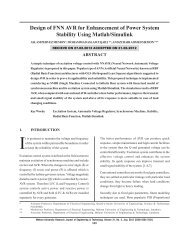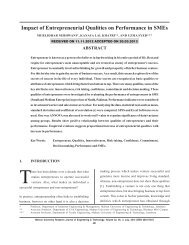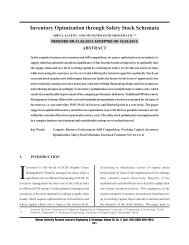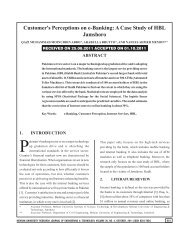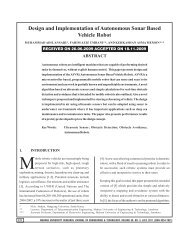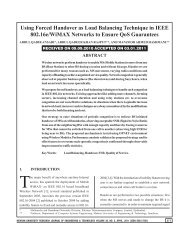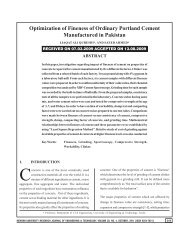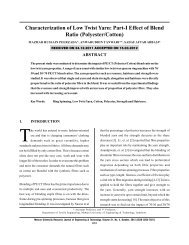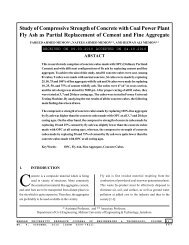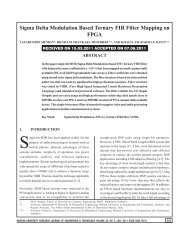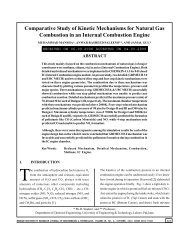(Laiq Khan-Sidra Mumtaz-Amjadullah Khattak). - Mehran University ...
(Laiq Khan-Sidra Mumtaz-Amjadullah Khattak). - Mehran University ...
(Laiq Khan-Sidra Mumtaz-Amjadullah Khattak). - Mehran University ...
- No tags were found...
Create successful ePaper yourself
Turn your PDF publications into a flip-book with our unique Google optimized e-Paper software.
Comparison of Genetic Algorithm and Harmony Search forGenerator Maintenance SchedulingLAIQ KHAN*, SIDAR MUMTAZ**, AND AMJADULLAH KHATTAK***RECEIVED ON 10.06.2010 ACCEPTED ON 04.10.2010ABSTRACTGMS (Generator Maintenance Scheduling) ranks very high in decision making of power generationmanagement. Generators maintenance schedule decides the time period of maintenance tasks and areliable reserve margin is also maintained during this time period. In this paper, a comparison of GA(Genetic Algorithm) and HS (Harmony Search) algorithm is presented to solve generators maintenancescheduling problem for WAPDA (Water And Power Development Authority) Pakistan. GA is a searchprocedure, which is used in search problems to compute exact and optimized solution. GA is consideredas global search heuristic technique. HS algorithm is quite efficient, because the convergence rate ofthis algorithm is very fast. HS algorithm is based on the concept of music improvisation process ofsearching for a perfect state of harmony. The two algorithms generate feasible and optimal solutions andovercome the limitations of the conventional methods including extensive computational effort, whichincreases exponentially as the size of the problem increases. The proposed methods are tested, validatedand compared on the WAPDA electric system.Key Words:GMS, Power System, Optimization, GA, HS Algorithm.1. INTRODUCTIONTo avoid premature failure of generators in a powergeneration system, it is important to performmaintenance at consistent intervals. GMS is vitalto provide secure and reliable operation of a powergeneration system. The main aim of GMS is to specify anoptimized generators maintenance timetable in order toachieve system reliability, decrease total operating costs,maximize the reserve margin and enhance generator lifespan, while, satisfying maintenance window constraints,crew constraints and load constraints.GMS is a large-scale, nonlinear and stochastic optimizationproblem with many constraints and conflicting objectivefunctions [1]. Different mathematical, heuristic and otheroptimization techniques are applied to solve GMS problem.Thus, much earlier work relied on methods such as dynamicprogramming [2-3], mixed integer nonlinear programming[4], integer programming [5-6] and branch and boundtechnique [7] with their performances demonstrated withrespect to simple case studies. In order to obtainapproximate solution of a complex GMS, new concepts* Professor, Department of Electrical Engineering, COMSATS Institute of Information Technology, Abbottabad.** Lecturer, Department of Electrical Engineering, COMSATS Institute of Information Technology, Abbottabad.*** Associate Professor, Department of Electrical Engineering, <strong>University</strong> of Engineering & Technology, Peshawar.<strong>Mehran</strong> <strong>University</strong> Research Journal of Engineering & Technology, Volume 31, No. 4, October, 2012 [ISSN 0254-7821]587
Comparison of Genetic Algorithm and Harmony Search for Generator Maintenance SchedulingNo.TABLE 1. DATA OF WAPDA SYSTEM (GENERATIONS, DURATION, ETC.)Power Capacity Earliest Latest Outage Available RequiredPower Capacity Earliest Latest Outage Available RequiredNo.Stations (MW) Period Period Weeks Man Manpower Stations (MW) Period Period Weeks Man Manpower1 TPS GUDDU: ST-1 5 0 7 2 3 4 4 0 10+10+10+10 69 GT-8 7 7 3 8 5 2 3 2 0 10+5+52 ST-2 7 5 2 9 4 5 4 4 0 10+10+10+10 70 SGT-9 (GT1,3) 105 2 8 4 3 3 2 0 10+5+53 ST-3 150 3 6 5 2 1 0 10020+20+20+1010+10+5+57 1 SGT-10 (GT2,4) 9 9 1 1 8 8 5 0+5+5+5+5+5+5 +5+5+5+520+20+20+204 ST-4 150 2 4 5 0 1 4 150 +10+10+10+10 72 SGT-11 (GT5,6) 8 6 2 8 4 6 6 3 5 10+5+5+5+5+5+5+5+5+5+5+55 CC-5 (GT7-8) 7 0 3 9 5 2 3 3 0 10+10+10 73 SGT-12 (GT7,8) 8 4 3 8 5 2 3 2 0 10+5+520+20+20 25+25+206 CC-6 (GT9-10) 6 5 1 2 0 1 0 100 +10+5+5+5 74 GT-13 113 3 2 5 2 9 125 +20+10+10+5+5+5 +5+5+525+25+207 GT-7 7 5 4 2 5 2 1 3 0 3 0 7 5 GT-14 115 3 3 5 2 9 125 +20+10+10+5+5+525+25+208 GT-8 8 0 8 2 1 1 3 0 3 0 7 6 SGT-15 (GT13,14) 126 3 3 5 2 9 125 +20+10+10+5+5+59 GT-9 7 5 1 2 0 1 0 100 20+20+20+10+5+5+5 77 HCPC 1 2 9 3 5 4 8 1 5 0 5 0+5+5+51 0 GT-10 7 5 1 2 0 1 0 100 20+20+20+10+5+5+5 78 AES PAKGEN 350 2 8 4 8 4 250 100+50+50+50+5+5+51 1 GT-11 8 0 1 3 3 6 1 1 110 20+20+20+10+10+5+5 79 AES LALPIR 350 2 4 4 0 4 250 100+50+50+50+5+5+5+520+20+201 2 GT-12 115 1 6 3 9 1 1 110 +10+10+5+5 80 SABA 125 30 46 4 120 50+25+25+20+5+5+5+520+20+20+20 ROUSCH :1 3 CC-13 (GT11-12) 9 5 1 6 4 1 1 3 145 +10+10+10+10 81 Half 197 1 1 2 1 100 100+5+5+5+5+5 ComplexTPS 25+25+25+2514 JAMSORO: 180 20 45 13 200 +20+20+20+1082 Half Complex 197 7 2 0 1 100 100ST-1 +10+5+5+5+51 5 ST-2 180 1 1 4 6 20050+50+25+25+25+258 3 Half Complex 197 1 6 2 7 1 100 1001 6 ST-3 170 1 2 0 4 200 50+50+50+50 84 Half Complex 197 2 4 3 7 1 100 1001 7 ST-4 170 1 1 5 4 200 50+50+50+50 85 Half Complex 197 3 3 4 6 1 100 1001 8 GTPS KOTRI: GT-1 1 0 1 9 3 1 5 5+5+5 86 Half Complex 395 3 8 5 2 2 200 100+1001 9 GT-2 1 0 1 1 6 3 1 5 5+5+5 87 SEPCOL : U # 1 2 1 1 5 3 0 3 2 0 10+5+52 0 GT-3 2 0 3 0 4 5 3 2 5 10+10+5 88 U # 2 21 15 30 3 20 10+5+52 1 GT-4 2 0 1 4 3 6 1 0 6 510+5+5+5+5+5+5+5+5+589 U # 3 21 15 30 3 20 10+5+52 2 GT-5 2 0 7 2 7 8 5 0 10+10+5+5 90 U # 4 21 20 35 3 20 10+5+5+5+5+5+52 3 GT-6 2 0 1 1 2 6 3 2 5 10+10+5 91 U # 5 21 20 35 3 20 10+5+510+10+5+52 4 GT-7 4 0 1 1 9 1 3 6 5 +5+5+5+5 9 2 U # 6 1 7 20 35 3 15 5+5+5+3+3+3+3+32 5 TPS M.GARH: ST-1 185 3 5 5 1 4 125 50+25+25+25 93 JAPAN 120 7 2 1 2 100 50+502 6 ST-2 200 3 5 5 1 4 175 50+50+50+25 94 CNPP 3 0 0 3 0 5 2 3 2 0 0 100+50+5050+25+202 7 ST-3 160 1 2 3 1 3 155 +10+10+5+5 95 TERBELA :1 175 1 1 6 4 150 50+50+25+25+5+5+5+5+5+550+25+202 8 ST-4 245 3 3 5 2 1 3 155 +10+10+5+5 96 2 200 10 25 4 150 50+50+25+25+5+5+5+5+5+52 9 ST-5 170 4 0 5 2 4 200 50+50+50+50 97 3 200 5 20 4 150 50+50+25+2550+25+203 0 ST-6 170 3 0 5 2 1 3 155 +10+10+5+5 98 4 175 1 13 4 150 50+50+25+25+5+5+5+5+5+5NGPS 10+10+5+5+53 1 MULTAN: 3 0 2 9 5 2 1 7 8 1 +5+5+5+5+5+3 9 9 5 200 3 0 5 2 4 150 50+50+25+25ST-1 +3+3+3+3+3+33 2 ST-2 3 0 4 0 5 2 4 2 0 5+5+5+5 100 6 200 30 52 4 150 50+50+25+25<strong>Mehran</strong> <strong>University</strong> Research Journal of Engineering & Technology, Volume 31, No. 4, October, 2012 [ISSN 0254-7821]589
Comparison of Genetic Algorithm and Harmony Search for Generator Maintenance SchedulingNo.Power Capacity Earliest Latest Outage Available RequiredPower Capacity Earliest Latest Outage Available RequiredNo.Stations (MW) Period Period Weeks Man Manpower Stations (MW) Period Period Weeks Man Manpower3 3 ST-4 3 0 2 6 5 2 4 2 0 5+5+5+5 101 7 200 10 26 4 150 50+50+25+2534GTPS19 20 40 8 305+5+5+3+3F. ABAD: GT-1 +3+3+33 5 GT-2 1 9 1 1 3 1 8 3 03 6 GT-3 1 9 2 2 2 8 3 03 7 GT-4 1 9 3 1 5 1 8 3 05+5+5+3+3+3+3+35+5+5+3+3+3+3+35+5+5+3+3+3+3+32.1 Objective Function and ConstraintsFormulationReserve based objective function is the most appropriateto solve the GMS problem. So GMS objective functionmaximizes the minimum reserve margin during eachgeneration. Let T (weeks)ind⊂ T (weeks)is the set of weeks whenmaintenance of generator ind may start. So for each unitind:102 8 175 5 21 4 150 50+50+25+25103 9 175 46 52 1 100 100104 10 432 36 52 4 150 50+50+25+25105 11 432 1 12 3 150 50+50+503 8 GT-5 2 3 2 2 0 4 2 0 5+5+5+5 106 12 432 43 52 3 150 50+50+503 9 GT-6 2 3 3 1 5 5 1 9 5+5+3+3+3 107 13 432 2 17 3 150 50+50+504 0 GT-7 2 3 2 1 7 1 2 0 2 0 108 1 4 432 5 2 1 3 150 50+50+504 1 GT-8 2 3 5 2 5 3 1 1 5+3+3 109 G.BAROTTHA : 1 240 1 2 5 5 110 50+25+20+10+54 2 CC-9 4 2 4 0 5 2 4 3 0 10+10+5+5 110 2 290 1 10 4 120 50+25+25+204 3 SPS F. ABAD: ST-1 5 0 3 7 5 2 4 4 0 20+10+5+5 111 3 290 43 52 3 125 50+50+254 4 ST-2 5 0 4 2 5 2 4 4 0 20+10+5+5 112 4 290 1 14 4 120 50+25+25+204 5 KEL : U # 1 1 5 2 1 3 6 3 2 0 10+5+5 113 5 290 2 17 3 125 50+50+2546 U # 2 15 15 30 3 20 10+5+5 114 MANGLA : 1 100 1 1 4 5 9 5 25+20+20+10+1047 U # 3 15 20 35 3 20 10+5+5 115 2 100 42 52 3 125 50+50+2548 U # 4 15 5 20 3 20 10+5+5 116 3 100 30 46 3 120 50+50+2049 U # 5 10 1 13 3 20 10+5+5 117 4 100 25 40 3 120 50+50+2050 U # 6 15 2 17 3 20 10+5+5 118 5 100 43 52 3 125 50+50+2551 U # 7 15 1 9 3 20 10+5+5 119 6 100 1 9 3 125 50+50+2552 U # 8 15 41 52 3 20 10+5+5 120 7 100 1 12 2 100 50+5053 STG 6 2 18 4 12 3+3+3+3 121 8 100 41 52 1 50 5054FKPCL:Full Complex151 24 37 1 50 50 122 9 100 40 52 2 100 50+505 5 Full Complex 151 3 7 5 2 3 150 50+50+50 123 10 100 30 52 2 100 50+505 6 LIBERTY 211 1 1 2 2 200 100+100 124 WARSAK : 1 4 0 3 7 52 6 29 10+5+5+3+3+357 UCH 551 37 52 4 250 100+50+50+50 125 2 40 41 52 4 21 10+5+3+35 8 HUBCO : U # 1 300 2 2 3 9 5 255 50+50+50+50+25 126 3 4 0 1 1 4 6 2 9 10+5+5+3+3+359 U # 2 300 38 52 2 100 50+50 127 4 40 2 17 3 18 10+5+36 0 U # 3 300 3 3 5 0 5 255 50+50+50+50+25 128 5 4 1 2 1 6 2 1 5 10+550+25+2561 U # 4 300 4 26 10 200 +20+20+20 129 CHASHMA : 1 2 3 1 1 2 2 1 5 10+5+20+10+5+56 2 KAPCO : GT-1 9 3 2 8 4 3 3 9 5 50+25+20 130 2 23 1 14 6 22 5+5+3+3+3+325+20+206 3 GT-2 9 2 1 2 0 1 0 9 7 +10+5+5+3 131 3 23 7 21 2 15 10+5+3+3+36 4 GT-3 8 1 1 1 8 7 4 96 5 GT-4 8 0 1 1 8 8 5 020+10+5+5+3+3+310+10+5+5+5+5+5+5132 4 23 1 14 2 15 10+5133 5 23 42 52 3 18 10+5+36 6 GT-5 7 8 2 8 4 6 6 3 5 10+5+5+5+5+5 134 6 23 41 52 4 16 5+5+3+36 7 GT-6 7 8 2 8 4 6 6 3 5 10+5+5+5+5+5 135 7 23 4 18 2 15 10+56 8 GT-7 7 9 3 3 5 2 8 5 010+10+5+5+5+5+5+5136 8 23 1 16 4 16 5+5+3+3t (week)ind= {tnd⊂ T (weeks): ear ind< tnd < lat ind-dur ind+1} (1)Equation (1) gives the specified time period during whicha generator is maintained. If a generator is off-line formaintenance then '1' is used to represent that the generatoris on maintenance whereas, '0' indicates that generator isnot on maintenance.1 if unit ind starts maintenance in tnd weeks,U ind,tnd=o (2)0 otherwise<strong>Mehran</strong> <strong>University</strong> Research Journal of Engineering & Technology, Volume 31, No. 4, October, 2012 [ISSN 0254-7821]590
Comparison of Genetic Algorithm and Harmony Search for Generator Maintenance SchedulingFor each unit ind I (units)and tnd ∈T (weeks)ind. Let S ind,tndis theset of start time periods. If maintenance of a unit starts atweek j, that unit must be maintained at period tnd. So:S ind,tnd= {j ∈T (weeks)ind: tnd-dur ind+ 1 < j < tnd} (3)The net reserve of the power generation system duringgenerators maintenance scheduling can be formulated as:(4)Subject to the maintenance window constraint:(5)The crew constraint:(6)The load constraint,(7)In case of constraints violation some penalty value is addedin the objective function.3. PROPOSED GENETIC ALGORITHMGA is superb for large sized problems, which havepotentially vast search space and the optimalcombinations are obtained by navigating through thesearch space. GA is a rigorous approach to solve GMSproblem. In the proposed GA, a chromosome of fixed lengthis used to solve the GMS problem. The chromosomeconsists of a number of genes and each gene representsthe maintenance start period of a generator. The size ofchromosome depends upon the number of generators usedin the power generation system. The value of each gene inthe chromosome is bounded by the earliest and lateststart period (week) of each generator.A power generation system consists ‘N’of number ofgenerators, the chromosome is:t 1,t 2,.....t i,.....,t N(8)Where t iis a gene of chromosome, which representsthe maintenance start week of generator i and isbounded by:ear i< t i< (lat i+ d uri+ 1) (9)TABLE 2. PEAK LOADS OF WAPDA SYSTEMInterval No. Peak Load Interval No. Peak Load Interval No. Peak Load1 6043 19 6,796 37 74292 5888 20 6,798 38 75103 6410 21 7146 39 75924 6440 22 7183 40 75395 6396 23 7251 41 74316 6650 24 7134 42 73527 6674 25 7467 43 74998 6408 26 7467 44 75669 6620 27 7351 45 746410 6604 28 7525 46 740111 6436 29 7513 47 735412 6550 30 7351 48 735413 6514 31 7584 49 683914 6478 32 7589 50 670115 6502 33 7653 51 660016 6631 34 6964 52 669117 6587 35 736418 6791 36 7514<strong>Mehran</strong> <strong>University</strong> Research Journal of Engineering & Technology, Volume 31, No. 4, October, 2012 [ISSN 0254-7821]591
Comparison of Genetic Algorithm and Harmony Search for Generator Maintenance SchedulingWhere ear iis the earliest start week, lat iis the latest startweek and dur iis the outage duration of generator i. Theevaluation function for the proposed GMS solution isshown in Equation (10):(vii)(viii)These new offsprings are kept in the newpopulation.Step 5 is repeated unless the fixed size (n) of newpopulation is achieved.fx_val=net_reserve + w 1x con 1+ w 2x con 2+ w 3x con 3(10)Where fx_val is the fitness value and net_reserverepresents the net reserve of a chromosome, which iscalculated by using Equation (4). w 1, w 2and w 3representthe weights of violations of con 1, con 2, and con 3. Theweights are the penalty values of the constraint violation.con 1represents the maintenance window constraint, whichis calculated by using Equation (5). con 2represents thecrew constraint, which is computed by using Equation(6). Crew constraint guarantees that required crew is lessthan or equal to available crew in each week. con 3represents the load constraint, which is calculated by usingEquation (7). The weight values for the constraint violationsare dominated over the objective function to make unfitchromosome a highly unfeasible solution.3.1 Genetic AlgorithmThe pseudo of proposed GA to solve GMS problem ofWAPDA is:(i) Represent a chromosome of fixed length (for 136-generators).(ii)(iii)(iv)(v)Reserve based evaluation function is defined.Initialize the GA with randomly selectedpopulation of size n.Calculate the fitness of each individual.Select the parent strings from the currentpopulation.(ix)Update the previous population with the newpopulation.The flowchart of proposed GA to solve GMS problem ofWAPDA power generation system is shown in Fig. 1.4. PROPOSED HARMONY SEARCHALGORITHMHS algorithm comprises of three main factors, which are:harmony memory, pitch adjustment and randomization.HM (Harmony Memory) is used to store the bestharmonies, which are selected as new solution vectors.HM accepting rate α acceptis responsible to store the bestharmonies in memory. Pitch adjustment is used to generateslightly different notes by adjusting the frequency. Thereare two important pitch adjustment's parameters, whichare: pitch bandwidth p bandwidthand pitch adjusting rate pα rate.In HS, pitch is adjusted linearly using Equation (11):R new= hold + p bandwidthx γ (11)Randomization is the last important component of the HSalgorithm. It is used to increase the diversity of thesolutions. The probability of randomization is computedby using Equation (12):R prob= 1 - α accept(12)The pitch adjustment probability is:p prob= α acceptx pα arate(13)(vi)Offsprings are created from the parent strings,which are selected in step 5. GA stochasticoperators, such as crossover and mutation,generate these offsprings.Generally, HM and pitch adjustment explores the localbest solutions, while the randomization computes theglobal best solutions. HS explores the best harmonies byusing Equation (10).<strong>Mehran</strong> <strong>University</strong> Research Journal of Engineering & Technology, Volume 31, No. 4, October, 2012 [ISSN 0254-7821]592
Comparison of Genetic Algorithm and Harmony Search for Generator Maintenance SchedulingFIG. 1. A COMPLETE GA CYCLE FOR WAPDA GMS SOLUTION<strong>Mehran</strong> <strong>University</strong> Research Journal of Engineering & Technology, Volume 31, No. 4, October, 2012 [ISSN 0254-7821]593
Comparison of Genetic Algorithm and Harmony Search for Generator Maintenance Scheduling4.1 HS AlgorithmThe pseudo of proposed HS to solve GMS problem ofWAPDA is:(1) The lower and upper limits of each generator forallowed maintenance period are defined.(2) HM is initialized with random solutions.(3) Each harmony is evaluated.(4) New harmonies are improvised using the existingbest harmonies.(5) HM is updated with these new harmonies.The flowchart of proposed HS to solve GMS problem ofWAPDA power generation system is shown in Fig. 2.FIG. 2. HS FLOW CHART FOR WAPDA GMS SOLUTION<strong>Mehran</strong> <strong>University</strong> Research Journal of Engineering & Technology, Volume 31, No. 4, October, 2012 [ISSN 0254-7821]594
Comparison of Genetic Algorithm and Harmony Search for Generator Maintenance Scheduling5. RESULTSThe important parameters for both proposed optimizationapproaches are listed in Table 3. GA and HS both areexecuted for 500 iterations with a population size of 20.The particular selection of parameters of both algorithmsgenerate the optimum maintenance schedule for generatorsof WAPDA power production system. Figs. 3-4 show theresults obtained using GA and HS respectively, whichcomprise of objective function convergence, weeklygeneration versus load demand, reserve margin of eachweek, available crew required by each generator, weeklymanpower required for maintenance and optimal schedulefor each generator. It is clear from Figs. 3-4 that the loadconstraint and crew constraint are completely satisfied.The main aim of this research is to achieve the maximumreserve margin in a week, so that load shedding problemshould be avoided. The maximum reserve margin obtainedfrom GA is 11,100 MW and HS is 10,800 MW, whereas theminimum reserve margin obtained from both algorithms is7,800 MW. The elapsed time of GA is 45 minutes, whereas,the elapsed time of HS is 5 minutes. GA objective functionconverges at 7,550 and HS converges at 7,400. If HS isexecuted for 45 minutes, then extremely better results canbe achieved as compared to GA.6. CONCLUSIONSGMS is the most important component in the decisionmaking of power generation management. This paperpresents a comparison of results of GA and HS to solveGMS problem for WAPDA system. Both proposedTABLE 3. GA AND HS PARAMETERSNo. GA Parameter Value HS Parameter Value1. Population size 20 HS size 2 02. Crossover rate 4 HM accept rate 0.953. Mutation rate 8 Pitch adjusting rate 0.74. Max generation 500 Pitch adjusting range 2005. - - Time Steps 500algorithms compute the generator’s best maintenanceschedule and reserve margin with the complete satisfactionof all mentioned constraints. It is concluded that theperformance of these algorithms is quite satisfactory butHS is quite fast and takes very less time for execution. Theresults obtained using HS are quite better than GA,therefore, HS gives a robust solution for generatormaintenance schedule problem.ACKNOWLEDGMENTThis work is carried out in the COMSATS <strong>University</strong>Institute of Information Technology, Abbottabad,Pakistan. The authors would like to thank WAPDA powerutility for providing the data for GMS problem.REFERENCES[1] Ben-Daya, M., Duffuaa, O.S., and Raouf, A.,"Maintenance Modeling and Optimization", KluwerAcademic Publishers, pp. 55, London, 2000.[2] Yamayee, Z.A., and Sidenblad, K., "A ComputationallyEfficient Optimal Maintenance Scheduling Method",IEEE Transactions on Power Apparatus and Systems,Volume PAS-102, pp. 330-338, 1983.[3] Kothari, D.P., "Fuzzy Dynamic Programming BasedOptimal Generator Maintenance SchedulingIncorporating Load Forecasting", IOS Press Amsterdam,pp. 233-249, 1997.[4] Escudero, L.F., Horton, J.M., and Scheiderich, J.E.,"Maintenance Scheduling of Production Unit", EuropeanJournal of Operational Research, Volume 9,pp. 264-274, March, 1982.[5] Mukerjee, R., Merrill, H.M., Erickson, B.W., Parker,J.H., and Friedman, R.E., "Power Plant MaintenanceScheduling Optimizing Economics and Reliability", IEEETransactions on Power Systems, Volume 6,pp. 476-483, 1991.[6] Edwin, K.W., and Curtius, F., "New MaintenanceScheduling Method with Production Cost Minimizationvia Integer Linear Programming", International Journalof Electrical Power and Energy Systems, Volume 12,pp. 165-170, 1990.<strong>Mehran</strong> <strong>University</strong> Research Journal of Engineering & Technology, Volume 31, No. 4, October, 2012 [ISSN 0254-7821]595
Comparison of Genetic Algorithm and Harmony Search for Generator Maintenance Scheduling(a) OBJECTIVE FUNCTION TRACE(D) CREW REQUIRED(B) AVAILABLE GENERATIONS AND LOADS(E) MANPOWER(C) RESERVE MARGIN(F) OPTIMAL MAINTENANCE SCHEDULE)FIG. 3. RESULTS FOR WAPDA SYSTEM USING GA[7] Chen, L.N., and Toyoda, J., "Optimal Generating UnitMaintenance Scheduling for Multi Area System withNetwork Constraints", IEEE Transactions on PowerSystems Volume 6, pp. 1168-1174, 1991.[8] Yellen, J., Al-Khamis, T.M., Vemuri, S., and Lemonidis,L., "Decomposition Approach to Unit MaintenanceScheduling", IEEE Transactions on Power Systems,Volume 7, pp. 726-733, 1992.<strong>Mehran</strong> <strong>University</strong> Research Journal of Engineering & Technology, Volume 31, No. 4, October, 2012 [ISSN 0254-7821]596
Comparison of Genetic Algorithm and Harmony Search for Generator Maintenance Scheduling(A) OBJECTIVE FUNCTION TRACE(D) CREW REQUIRED(B)AVAILABLE GENERATIONS AND LOADS(E) MANPOWER(C) RESERVE MARGINFIG. 4. RESULTS FOR WAPDA SYSTEM USING HS(F) OPTIMAL MAINTENANCE SCHEDULE)[9] Stremel, J.P., "Maintenance Scheduling for GeneratingSystem Planning", IEEE Transactions on PowerApparatus and Systems, Volume 100, pp. 1410-1419,1981.[10] Duval, P.E., and Poilpot, R., "Determining MaintenanceSchedule for Thermal Production Units: The KAPILAModel", IEEE Transactions on Power Apparatus andSystems, Volume 102, pp. 2509-2525, 1983.<strong>Mehran</strong> <strong>University</strong> Research Journal of Engineering & Technology, Volume 31, No. 4, October, 2012 [ISSN 0254-7821]597
Comparison of Genetic Algorithm and Harmony Search for Generator Maintenance Scheduling[11] Kralj, B.L., and Petrovic, R., "Optimal PreventiveMaintenance Scheduling of Thermal Generating Unitsin Power Systems: A Survey of Problem Formulationand Solution Methods", European Journal of OperationResearch, Volume 35, pp. 1-15, 1988.[12] Contaxis, G.C., Kavatza, S.D., and Vournas, C.D., "AnInteractive Package for Risk Evaluation andMaintenance Scheduling", IEEE Transactions on PowerSystems, Volume 4, pp. 389-395, 1989.[13] Lin, C.E., Huang, C.J., Huang, C.L., and Liang, C.C.,"An Expert System for Generator MaintenanceScheduling Using Operation Index", IEEE Transactionsin Power Systems, Volume 7, pp. 1141-1148, 1992.[14] Momoh, J.A., and Tomsovic, K., "Overview andLiterature Survey of Fuzzy Set Theory in Power Systems",IEEE Transactions on Power Systems, Volume 10,pp. 1676-1690, 1995.[15] Huang, C.J., Lin, C.E., and Huang, C.L., "Fuzzy Approachfor Generator Maintenance Scheduling", Electric PowerSystems Research, Volume 24, pp. 31-38, 1992.[16] Baskar, S., Subbaraj, P., Rao, M.V.C., and Tamilselvi, S.,"Genetic Algorithms Solution to Generator MaintenanceScheduling with Modified Genetic Operators", IEEEProceedings: Generation, Transmission and Distribution,pp. 56-66, 2003.[17] Wang, Y., and Handschin, E., "A New Genetic Algorithmfor Preventive Unit Maintenance Scheduling of PowerSystems", International Journal of Electrical PowerEnergy System, pp. 343-348, 2000.[18] Satoh, T., and Nara, K., "Maintenance Scheduling byUsing Simulated Annealing Method", IEEE Transactionon Power System, pp. 850-857, 1991.[19] El-Sharkh, M.Y., and El-Keib, A.A., "An EvolutionaryProgramming-Based Solution Methodology for PowerSystem Generation and Transmission MaintenanceScheduling", Electric Power Systems, pp. 35-40, 2003.[20] Park, J., Choi, J., Baek, U., Cha, J., and Lee, K.Y.,"Flexible Maintenance Scheduling of Generation Systemby Multi Probabilistic Reliability Criterion in KoreanPower System", Journal of Electrical Engineering &Technology, Volume 5, pp. 1-178, 2010[21] Changyou, F., Xifan, W., and Wenbo, W., "Power PlantMaintenance Scheduling Considering Unit Failure",Electric Power Automation Equipment, 2009.<strong>Mehran</strong> <strong>University</strong> Research Journal of Engineering & Technology, Volume 31, No. 4, October, 2012 [ISSN 0254-7821]598



